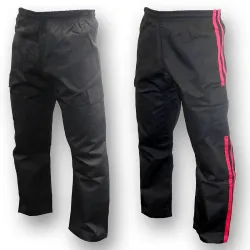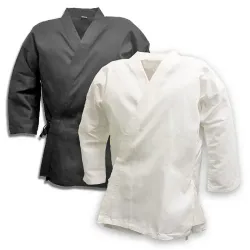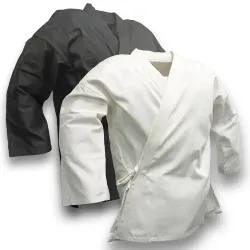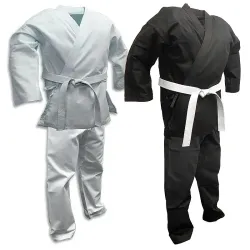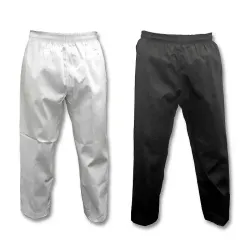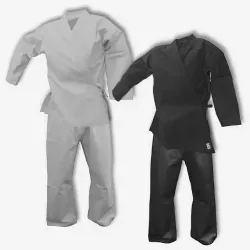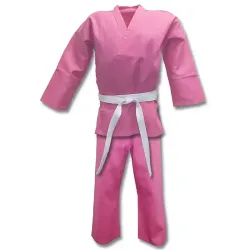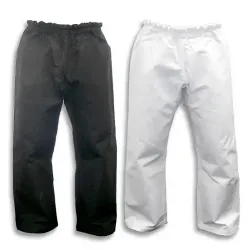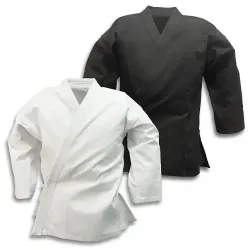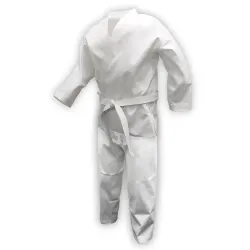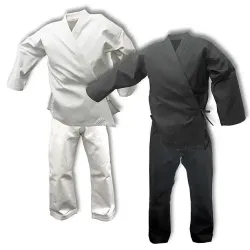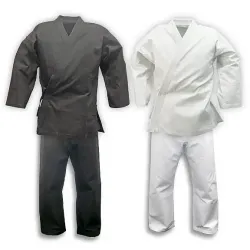Traditional Karate Uniforms and Gi
-
From $24.95
-
From $26.95
-
From $24.95
-
From $44.95
-
From $44.95
The traditional karate gi has earned its place as a staple in martial arts schools worldwide. Its versatility makes it a preferred choice for many disciplines, even beyond karate itself. While some styles like judo or jiu-jitsu demand specialized attire, the karate uniform's thoughtful construction ensures it accommodates the high kicks, stances, and techniques common across various practices. At KarateMart.com, we offer an array of options, from lightweight student uniforms to heavier designs, catering to the diverse preferences of martial arts instructors and students alike. Our traditional karate uniforms blend authenticity with practicality, making them a reliable choice for any dojo.
Choosing the right karate gi involves more than just picking a style - it's about aligning with your training goals and school requirements. Before making a purchase, consult your instructor about the ideal weight and color for your uniform. Many beginners start with a lightweight student uniform, prized for its breathability and ease of movement, while advanced practitioners might opt for a heavier karate gi that offers durability and a crisp, professional look. At KarateMart.com, we're proud to provide high-quality karate uniforms that strike the perfect balance between tradition and performance, ensuring you feel confident on the mat.
For those seeking value without compromising quality, KarateMart.com stands out with discount karate uniforms and wholesale karate uniforms tailored to fit any budget. Our commitment to affordability means you can equip yourself or your entire class with top-tier gear at competitive prices. Each karate uniform in our inventory is crafted to uphold the standards of martial arts training while keeping costs accessible. Have questions about sizing, styles, or other karate supplies? Our friendly customer service team is just a call away at 1-800-977-6928, ready to assist you in finding the ideal gi for your practice.
What is a Karate Gi?
A Karate Gi is the traditional uniform worn for training and competition in karate. It consists of a jacket, pants, and a belt, and is designed to give martial artists freedom of movement while maintaining a professional, traditional look. The word "gi" simply means "clothing" in Japanese, and over time, it has come to refer specifically to martial arts uniforms used in disciplines such as karate, judo, and jiu-jitsu.
A martial arts gi is typically made from cotton or a cotton-polyester blend, which helps it stay durable while remaining breathable during tough workouts. The material is woven tightly to handle grabbing, striking, and intense motion without tearing. Most gis are white, symbolizing purity and discipline, though black and blue are also common for modern schools and demonstrations.
The design of a Karate Gi serves both form and function. The loose sleeves and pants allow for a wide range of motion during kicks and punches, while the overlapping jacket provides a clean, traditional appearance. The belt (or obi) indicates the student's rank and ties the uniform together securely. Whether you're a beginner starting your first class or a black belt refining your techniques, the right gi helps you train with comfort, respect, and focus.
KarateMart.com offers a wide selection of karate uniforms in different weights and materials to suit every student's needs. Each gi is built for performance, combining traditional craftsmanship with modern durability so you can train with confidence every time you step into the dojo.
What's the difference between a Karate Gi and a Jiu-Jitsu Gi?
A Karate Gi is built for striking arts where speed, snap, and range of motion matter most, while a Jiu-Jitsu Gi is designed for gripping, pulling, and ground fighting. The cut, fabric, and reinforcements are tailored to the specific demands of each martial art.
Cut and fit:
Karate jackets are roomier in the shoulders with a longer, straighter skirt that allows high kicks and clean chambering. Sleeves are slightly wider to encourage freedom of movement. Jiu-Jitsu jackets are shorter with a closer athletic cut to reduce material opponents can grab, and their sleeves are narrower to limit easy grips.
Collar and lapel:
Karate lapels are thinner and designed to lie flat for comfort and speed. Jiu-Jitsu lapels are thick and heavily reinforced to withstand constant tugging, chokes, and grip fighting. The dense collar also helps the jacket keep its structure during intense grappling.
Reinforcement zones:
Karate uniforms focus on lightweight durability, using reinforced stitching at stress points while maintaining a breathable feel. Jiu-Jitsu gis use extra reinforcements at the collar, shoulders, cuffs, knees, and side vents since those areas experience frequent pressure and pulling.
Fabric and weave:
Most martial arts gi designs for karate use plain-weave cotton or poly-cotton blends that breathe well and produce a crisp snap during techniques. Jiu-Jitsu gis often use pearl weave or gold weave materials, which are thicker and textured to resist tearing during throws and groundwork.
Pants construction:
Karate pants are cut for kicking and flexibility, with lighter material and generous room in the hips and thighs. Jiu-Jitsu pants are heavier and have reinforced knees and tighter cuffs to withstand friction and limit an opponent's grip.
Weight and feel:
A typical martial arts karate gi ranges from lightweight to mid-weight, designed for speed and ventilation. Jiu-Jitsu gis are usually heavier for durability under tension, though modern competition versions have improved mobility while maintaining strength.
Rules and purpose:
Competition requirements also differ. Karate tournaments prioritize a clean silhouette and freedom of motion for striking, while Jiu-Jitsu tournaments often regulate jacket length, sleeve width, and collar thickness to ensure fair grip dynamics. If your focus is on striking, a karate gi offers speed and comfort. If you train primarily in grappling, a Jiu-Jitsu gi provides better protection and longevity.
Bottom line:
Choose the uniform designed for your discipline. A martial arts karate gi supports quick, fluid techniques and comfort during striking, while a Jiu-Jitsu gi is built for the rigors of grip fighting and ground control.
What weight should my Karate Gi be?
The right weight for your Karate Gi depends on your training goals, experience level, and comfort preferences. Karate uniforms come in four main weight categories: lightweight, medium weight, heavyweight, and super heavyweight. Each type feels and performs differently depending on how you train.
Lightweight Gi (around 6 ounces):
A lightweight gi is ideal for beginners or anyone who practices in warmer environments. The thinner fabric keeps you cool during long workouts and allows unrestricted motion for strikes and kicks. It's easy to wash, dries quickly, and provides great mobility, which makes it one of the most popular choices for students purchasing their first martial arts gi.
Medium Weight Gi (8-10 ounces):
A medium weight gi offers a perfect balance between comfort and durability. The fabric has more structure and produces a crisp "snap" sound when executing techniques. Many intermediate students prefer this weight because it maintains shape through repeated use and provides a traditional look during kata and competition.
Heavyweight Gi (12 ounces):
A heavyweight gi is made for advanced practitioners who value toughness and control. The thick fabric adds resistance, helping to develop strength and precision in techniques. Heavyweight uniforms also produce a stronger sound when striking and are favored by martial artists who want a professional appearance during demonstrations and tournaments.
Super Heavyweight Gi (around 14 ounces):
A super heavyweight gi is the most durable option available. The dense weave provides unmatched structure and feedback, making it ideal for high-level training or frequent competition. This type of uniform is designed to withstand years of use, and while it can feel warm and stiff at first, it softens with wear and delivers exceptional longevity.
Choosing the right weight:
If you're new to karate, a lightweight or medium weight gi will keep you comfortable as you develop technique and flexibility. As you progress, you may prefer a heavier uniform that adds structure and durability to your training. KarateMart.com offers Karate Gis in every weight class, so you can choose the perfect combination of comfort, quality, and performance for your needs.
How should a Karate Gi fit?
A Karate Gi should fit comfortably and allow you to move freely in every direction. It needs to feel loose enough for kicking and striking but not so baggy that it catches or looks sloppy. The right fit helps improve your technique, comfort, and overall presentation in the dojo or competition setting.
Jacket length and sleeves:
The jacket should wrap securely around your torso with enough overlap to stay closed while training. The sleeves should reach just above the wrists when your arms hang naturally at your sides. If the sleeves extend too far, they can get in the way during techniques. If they're too short, the jacket may ride up or feel restrictive.
Pants length and waist:
Your pants should sit comfortably at the waist with an adjustable drawstring or elastic band. The pant legs should fall just above the ankles to allow full range of motion for kicks and stances. A slightly shorter cut is common because it prevents tripping and keeps your movements clean and precise.
Overall fit and comfort:
A martial arts karate gi should feel relaxed but secure. You should be able to slide a closed fist between your body and the fabric around the chest or waist. This gives you enough space to move naturally and keeps the uniform breathable during training sessions. The jacket shouldn't pull when you extend your arms or twist your torso.
Accounting for shrinkage:
Cotton gis tend to shrink slightly after the first few washes, especially if they are air-dried in the sun or machine-dried on high heat. If your gi is 100% cotton, it's smart to size up so it fits properly after washing. Blended fabrics such as poly-cotton shrink less and keep their shape longer, making them easier to maintain for beginners.
Performance tailoring:
Some competitors prefer a slightly shorter jacket and sleeves for kata and tournament performance because it emphasizes clean form and technique. For everyday training or sparring, a looser cut provides more comfort and flexibility. The best fit is one that moves with your body and supports your specific style of training.
When your gi fits properly, you'll notice better range of motion, cleaner technique, and a more confident feel during practice. If you're unsure about sizing, refer to the KarateMart.com charts or consult your instructor for guidance based on your height and build.
What size Karate Gi should I buy?
Choosing the right size Karate Gi ensures you can train comfortably and move naturally without restrictions. Most gi sizing charts are based on your height first, then adjusted for weight and body type. Getting this balance right helps your uniform look professional and perform properly during training or competition.
Start with your height and weight:
Manufacturers size martial arts gis numerically, typically from size 000 for very small children up to size 8 for tall or heavy adults. Each size usually covers a height range of about 3 to 4 inches. For example, someone who is 5'8" and 160 pounds will likely wear a size 4, while someone around 6 feet tall might need a size 5. Always check the specific size chart on KarateMart.com, as different brands can vary slightly.
Account for fabric type and shrinkage:
If your uniform is made from 100% cotton, expect it to shrink slightly after washing. Many students buy one size larger to allow for that adjustment. Poly-cotton blends shrink much less and are easier to maintain, which makes them a good option for beginners who want a consistent fit over time. Pre-shrunk gis are also available for those who prefer an exact fit right out of the package.
Consider your training focus:
If you train primarily for speed, kata, or demonstrations, a slightly fitted gi can enhance movement and presentation. For sparring or everyday training, a looser fit often feels more comfortable and breathable. A martial arts gi should always allow you to perform kicks, blocks, and strikes without restriction.
When in doubt, size up:
If your measurements fall between two sizes, it's usually best to go with the larger one. A gi that's too small can restrict movement and wear out faster at the seams. Larger uniforms can always be hemmed or adjusted for length, but you can't add extra room once it's too tight.
A well-sized gi moves with your body and enhances performance instead of holding you back. Take a minute to review the KarateMart.com size chart before ordering so you can step into training with a uniform that fits perfectly from the start.
How do I care for my Karate Gi?
Taking proper care of your Karate Gi helps it last longer, stay comfortable, and look sharp for every class. Because a gi absorbs sweat, friction, and impact during training, regular cleaning and correct handling are essential to maintain its strength and appearance.
Washing your gi:
Wash your uniform in cold or lukewarm water using a gentle detergent. Hot water can shrink cotton fabric and weaken the fibers over time. Avoid using bleach, as it can damage stitching and cause yellowing. If your gi smells from frequent training, add a small amount of white vinegar to the wash to neutralize odor naturally.
Drying tips:
Air drying is the best method for maintaining the integrity of your gi. Hang it on a sturdy hanger or clothesline in a shaded area to prevent sun fading. If you need to use a dryer, choose the lowest heat setting and remove the gi while it's still slightly damp to avoid shrinkage. This also keeps the material soft and flexible.
Ironing and storage:
If you want your gi to look crisp, iron it on a low or medium setting while it's still slightly damp. Avoid direct heat on patches or embroidery. Once dry, store your gi on a hanger or neatly folded to prevent wrinkles. Keeping it clean and ready to wear shows respect for your dojo and discipline.
Frequency of washing:
After each training session, allow your gi to air out, even if you don't wash it immediately. Wash it at least every other use to remove sweat and bacteria. Frequent washing also helps prevent buildup that can cause fabric stiffness over time. A clean gi not only feels better but also promotes hygiene and professionalism.
Preserving color and longevity:
If you own a colored martial arts karate gi, wash it separately for the first few cycles to prevent dye transfer. Turning the gi inside out before washing helps protect patches and screen-printed logos. Following these simple care steps will help your uniform last longer, retain its shape, and stay comfortable through years of training.
Proper care keeps your gi looking clean, smelling fresh, and performing like new. With regular maintenance and a little attention to detail, your uniform will reflect the same discipline and pride you bring to every class.
Can I use my Karate Gi for other martial arts?
In some cases, yes, but it depends on the type of martial art you are practicing and how demanding the techniques are. A Karate Gi is designed specifically for striking-based styles such as karate and taekwondo, where mobility, speed, and ventilation matter more than fabric strength. Other martial arts may require uniforms that can handle gripping, pulling, or groundwork that a standard karate uniform is not built for.
Striking-based martial arts:
If you train in styles such as taekwondo, tang soo do, or other stand-up disciplines, your Karate Gi will work well. These arts use similar movement patterns that rely on fast kicks, punches, and stances, so a lightweight or medium weight gi offers plenty of flexibility and comfort.
Grappling or throwing arts:
For arts that involve clinching or ground fighting, such as judo or Brazilian jiu-jitsu, a Karate Gi will not hold up as effectively. A judo or jiu-jitsu gi uses thicker fabric, reinforced stitching, and a stronger collar to resist tearing when grabbed. A traditional martial arts gi made for karate could rip or stretch if used often in grappling classes.
Hybrid or cross-training:
If you practice multiple disciplines, it is often better to have separate uniforms for each. Many students keep their Karate Gi for striking practice and use a different uniform for grappling or weapons training. This prevents excessive wear and allows each gi to perform its best while providing the right combination of durability and comfort.
A Karate Gi is perfect for striking-focused martial arts and general dojo training. However, if you plan to train in styles that include heavy grabbing or throwing, it is wise to use a uniform designed for those techniques. The right gi will protect your body, last longer, and help you train more effectively.
What's the difference between a Karate Gi and a Judo Gi?
While both uniforms share similar roots, a Karate Gi and a Judo Gi are designed for very different styles of training. The main differences come down to fabric thickness, reinforcement, and overall durability. Karate is a striking art, while Judo focuses on throws and grappling, so each uniform has evolved to meet those specific demands.
Fabric thickness and weight:
A Karate Gi is made from a lighter material that promotes speed and flexibility. It allows martial artists to move quickly and execute high kicks and punches without restriction. A Judo Gi, on the other hand, uses a much heavier cotton weave. The extra thickness helps prevent tearing during throws and grips, which are common in Judo practice.
Reinforcement and stitching:
Because Judo involves constant grabbing and pulling, a Judo Gi includes reinforced seams at the collar, shoulders, cuffs, and knees. The stitching is denser and often layered multiple times for added strength. A Karate Gi focuses more on breathability and range of motion, using lighter stitching that keeps the uniform cool and fast-moving during training.
Cut and fit:
Karate uniforms are generally cut longer and looser to allow freedom of movement for strikes and stances. Judo uniforms fit closer to the body and have shorter sleeves and skirts to reduce excess fabric that an opponent can grab. The tighter design makes it easier to maintain control during grappling exchanges.
Collar design:
The collar on a Judo Gi is thick and heavily padded so it can endure grip fighting and chokes. The collar on a Karate Gi is much thinner, allowing for comfort and ease of movement during striking drills. This difference alone makes a martial arts gi for Karate unsuitable for grappling arts that rely on strong grips.
Purpose and performance:
If your primary focus is striking, a Karate Gi offers speed, comfort, and a traditional look that complements your training style. If your training involves throws, holds, or ground work, a Judo Gi provides the strength and reinforcement needed to withstand intense grappling. Using the correct gi for your discipline ensures better performance and a longer-lasting uniform.
What color Karate Gi should I wear?
The color of your Karate Gi usually depends on your dojo's traditions, competition rules, and personal preference. Most schools require a white uniform because it represents purity, discipline, and respect for the art. However, other colors such as black, blue, or red are sometimes used for advanced students, instructors, or demonstrations.
Traditional white gi:
White is the most common choice and the standard color for most dojos around the world. It reflects the traditional values of karate and keeps the focus on form and technique rather than appearance. A white gi also makes it easier for instructors to see your body mechanics and posture during training.
Black or colored gi:
Some schools allow black or colored uniforms for senior students, instructors, or specific styles. Black gis are often seen in modern systems or mixed martial arts programs where the rules are less formal. These uniforms can give a sharp, authoritative look but should only be worn if approved by your instructor.
Competition and demonstration colors:
In tournaments, most competitors wear white, but certain organizations allow red or blue gis to help judges differentiate between opponents. For demonstrations or team events, colored uniforms can be used to showcase school identity or rank. Always check the event's dress code before wearing anything other than white.
Material and care considerations:
Darker uniforms can show lint or fading more easily over time. If you choose a black or colored martial arts gi, wash it in cold water and hang dry it to preserve the fabric and color. Turning it inside out before washing also helps maintain the finish.
In most cases, a clean, well-fitted white gi will meet every dojo's expectations and show respect for the traditions of karate. If your instructor permits color options, pick one that reflects your rank and training environment while still maintaining a professional appearance.
Why are Karate Gis white?
The Karate Gi is traditionally white because it represents purity, discipline, and humility. In Japanese martial arts culture, white symbolizes a beginner's mindset and a willingness to learn. Wearing a white gi reminds every student, regardless of rank, that there is always more to study and improve upon.
Symbolism and tradition:
The color white has deep cultural roots in Japanese martial arts. It reflects respect for the dojo, the instructor, and the practice itself. The founder of modern karate, Gichin Funakoshi, helped popularize the white gi after seeing similar uniforms used in judo. The goal was to promote unity and equality among students, with rank represented only by the color of the belt rather than the uniform itself.
Practical reasons:
White uniforms make it easier to spot movement, body position, and technique during training. Instructors can quickly identify errors in form or balance when everything is visible against the clean background of a white gi. White fabric also absorbs heat less than darker colors, keeping students cooler during long classes or summer training sessions.
Cleanliness and respect:
Because white shows dirt easily, it encourages students to maintain high standards of hygiene and care. Keeping a martial arts karate gi clean is viewed as a reflection of discipline and personal pride. A freshly washed gi shows respect for your dojo and training partners.
Modern variations:
While white remains the traditional color, some dojos now allow black or colored gis for advanced students, instructors, or special events. However, the white uniform continues to be the universal symbol of karate's traditions and values, representing both the simplicity and the spirit of the art.
Wearing a white gi connects every practitioner to centuries of martial arts history. It serves as a daily reminder of humility, perseverance, and the shared journey toward mastery that defines karate training.
What is the best Karate Gi for beginners?
The best Karate Gi for beginners is one that offers comfort, mobility, and durability without feeling too heavy or restrictive. When you are starting out, your main goal is to learn proper form and movement, so your uniform should help you focus on technique instead of worrying about fabric weight or stiffness.
Start with a lightweight uniform:
A lightweight gi, typically around six ounces, is ideal for new students. The thinner material keeps you cool during long classes and allows unrestricted motion for punches, blocks, and kicks. It is also easier to wash and dry, which makes it perfect for regular training schedules. Most beginners find that a lightweight martial arts gi helps them move naturally and stay comfortable as they build confidence.
Choose the right material:
Poly-cotton blends are an excellent choice for new martial artists. They resist shrinkage, stay soft after washing, and are less likely to wrinkle than 100% cotton. This makes them easier to care for and more forgiving as you learn how to tie and maintain your uniform properly.
Fit and sizing:
Beginners should look for a gi that fits slightly loose to allow freedom of movement. The sleeves should reach just above the wrists, and the pants should stop near the ankles. If the uniform feels tight in the shoulders or legs, go up one size to ensure comfort during training. A good fit will let you move fluidly without feeling restricted.
Focus on durability and value:
Even though beginners do not need a competition-level uniform, a well-made gi can handle daily training and occasional washing without fraying. Reinforced stitching and quality fabric help your uniform last longer, saving money over time. KarateMart.com offers affordable beginner uniforms that combine comfort, strength, and traditional style to help new students start their journey with confidence.
A good beginner gi should be lightweight, breathable, and easy to maintain. Once you develop more experience and refine your techniques, you can upgrade to a heavier or specialized uniform for competition or advanced practice.





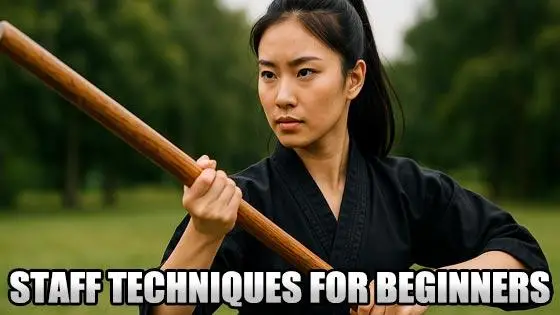


 (5)
(5)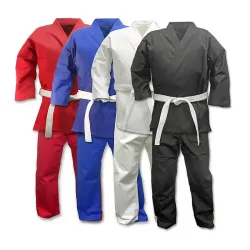

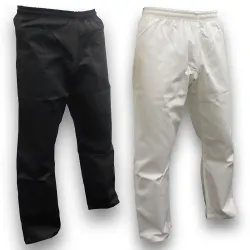
 (3)
(3)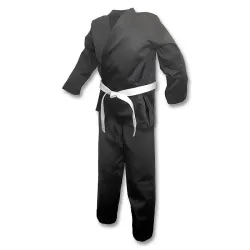
 (1)
(1)